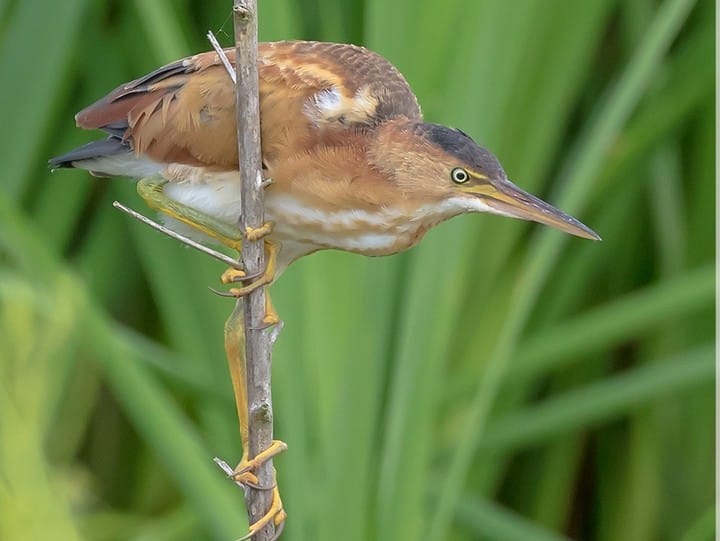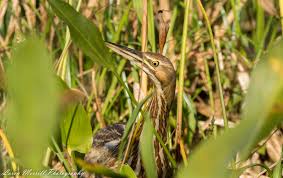by BA Nester
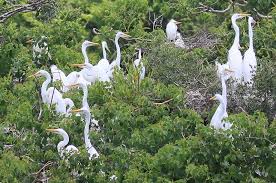
BITTERNS:
The LEAST BITTERN is a beautiful and fascinating bird! Their lovely chestnut, buff and black feathers are perfect camouflage in the wetlands they inhabit. The plainer females have a dark brown back and crown. Typical to many of the others in the heron family, the best time to spot them is dusk or dawn at the edges of cattail and reedy waters. They are the smallest of the Ardeidae family, with long, pointy, yellow bills. While we usually see them all hunched up, they have longish necks which, when they are startled, they will stop-short, distend their necks with their bills pointing straight up! They sometimes sway a bit, so they look like the marsh reeds, blowing in the wind! Even the very young chicks “strike the bittern pose” when they are alarmed!
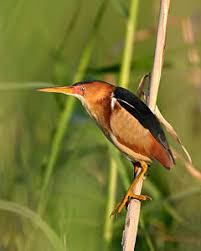
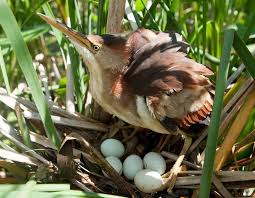
The AMERICAN BITTERN is such a well-camouflaged bird that they are seldom spotted. More often they are heard, especially in the Spring ” when the marshes resound with their odd booming calls that sound like the gulps of a thirsty giant.” As a matter of fact, they have some pretty humorous localized nicknames: “stake-driver,” “thunder-pumper,” “water-belcher,” and “mire-drum.”
The feather pattern of the American Bittern is a very streaked brown, with white and a warm buff color, perfect camouflage for the marshes in which they live. They are a mid-sized heron with a thicker neck and body, and shorter legs than their cousins. Typical of the heron family, they are bug, fish, small mammal and amphibian eaters. They are patient, stalking hunters, most often seen on the edges of the reed or mangrove swamps as they slip in and out of the reeds.
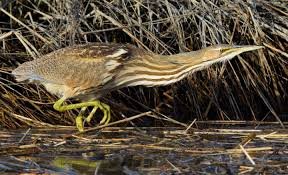
I do think the female American Bitterns should have a long talk with their smaller cousins, the Least Bitterns, because the female American Bittern gathers materials, builds the nest, incubates eggs, broods, and feeds chicks with no apparent help from the male. Tsk, tsk, tsk.
The American Bittern also strikes the “Bittern Pose” when startled. So, find a comfy spot and patiently scan the edges of shallow, fresh-water marshes and wait for one to materialize.

EGRETS:
There are 4 species of Egrets in this large family: Cattle Egret, Snowy Egret, Reddish Egret, Great Egret. Egrets share the same build as the Herons, but have mostly white feathers and, during breeding season, they have beautiful white plumes! These plumes were the cause of their near extinction in the late 1800s as they were coveted in the millinery trade! This near catastrophe heated up in the conservation circles and was the impetus of some of the first bird protection laws! The Egrets have long legs, and long, curved necks. Their beaks are long and pointy and are typically used for catching fish. The Snowy and Cattle Egrets are smaller, while the Great Egrets grow over 3′ tall and the Reddish are just under 3′. The Great Egrets have a wingspan of approximately 5′ – 5.5′! Very impressive birds!
The CATTLE EGRET is the most unique of the Heron Family members in that it spends most of its time in agricultural fields with grazing animals, eating bugs, little birds or amphibians that they stir up as they meander through the fields. You might also see them on the back of the cattle, dining on ticks! This short and stocky Egret bobs his head as he walks. He is white with short, orangish plumes on it’s head and neck during breeding season. They have yellow bills and legs, except for the immatures who have blackish legs and bills.


Cattle Egret are originally an African species, but somehow or other were introduced in South America in the late 1800s, reaching the USA in the 1940s and establishing nesting sites in the 1950s. Today they are the most commonly seen of all Egrets. They too are colony nesters and will often nest with other, larger egrets and herons.
The SNOWY EGRET is one of my personal favorites with it’s gorgeous white feathers, black bill and legs, but with yellowish feet that turn orangy-red during breeding season! The bare skin on their faces, between their eyes and their bill will also turn from yellow to reddish! Very pretty! Of course, just to make our ID-ing hard, the Snowys have been known to mate with other Heron species and to produce hybridized offspring! So, if they mate with a Little Blue Heron or a Tricolored Heron or even a Cattle Egret, who knows what they will look like!
Snowy Egrets are primarily coastal or tidal water birds, although the migrate through the middle of the country and have some inland breeding areas. The Snowys pretty yellow feet are used in stirring up the sand and mud to dislodge or herd up aquatic creatures for a tasty meal! These birds are also colonial nesters with the males choosingthe nesting site, usually at the top our out branches of trees or shrubs. After he selects a mate, the female will finish building the nest with the materials the male brings.
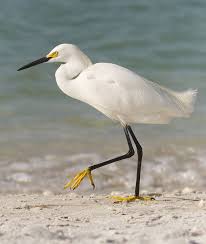

This description from All About Birds is so wonderful: Male Snowy Egrets fight for breeding territories, choose nest sites, and perform noisy courtship displays to attract mates. A ring of other egrets often gathers around a displaying male as he pumps his body up and down, points his bill skyward, and calls. He also performs aerial displays, including one that ends with him dropping toward the ground while tumbling around and around. After pairing up, Snowy Egrets continue defending the immediate area around the nest, raising their crests and giving rasping calls. The Snowy Egret is a thoroughly delightful bird!
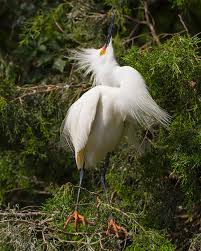
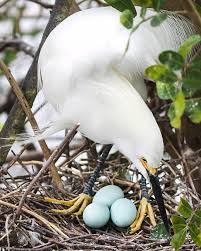

The REDDISH EGRET is REALLY easy to confuse with the Little Blue Heron! The Little Blues are smaller and have purple-ish feathers rather than the rusty-reddish feathers of the Reddish Egret. But, I gotta tell ya, out in the field, relative size and colors can be really confusing! Their bills have a pink base and a black tip, while the Little Blues bill have a two-toned gray. Just to add more confusion to making field IDs, the Reddish Egret has an all-white phase!!! At breeding time, the white phase has a distinctly pink bill with a black tip. Although if it’s a juvenile white-morph, it’s bill is all black! It’s crazy!
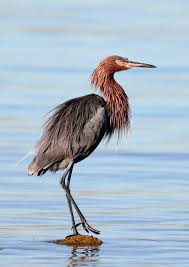

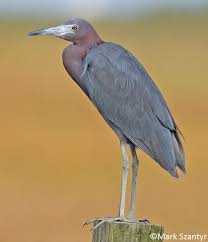

The Reddish Egret, unlike most of the rest of the Heron family is found ONLY in coastal areas where is can find a lovely aquatic meal. It, too, builds its stick nests in trees, in colonies with other egrets and herons, frequently on small, unpopulated islands. We had several small, “bird islands” in the wide areas of the intracoastal waterways that were fully used as heron and egret nesting sites. They were noisy and “fragrant” if you got downwind from them in your boat. But we had the pleasure of seeing all of the various species of egrets and herons!
The GREAT EGRET is truly an elegant bird! It, too, was almost hunted to extinction in the late 1800s, all for its fabulous white feathers to be used in ladies’ hats! The Great Egret is just slightly smaller than the Great Blue Heron, but when you see one, you will be thrilled at its size! When we lived in the St. Petersburg area of FL, we had them in our yard all of the time. They nested on the “bird islands” in the Intracoastal Waterway with all of their cousins. They, too, are colonial nesters with their big old stick nests. They fished the mangroves and shallows at low tide, and they stalked the shrubs of our yard, looking for chameleons and anole lizards. Now that we live inland in NE Florida, they STILL stalk our yard in search of lizards clinging to the screened lanai and they fish the edges of the ponds in search of frogs, crayfish and fish that they can stab with their sharp bills! It’s really fun to watch them! They move very slowly, then freeze when they spot their meal …. faster than you can imagine, they strike! And gulp, gulp, the anole or little snake is gone!
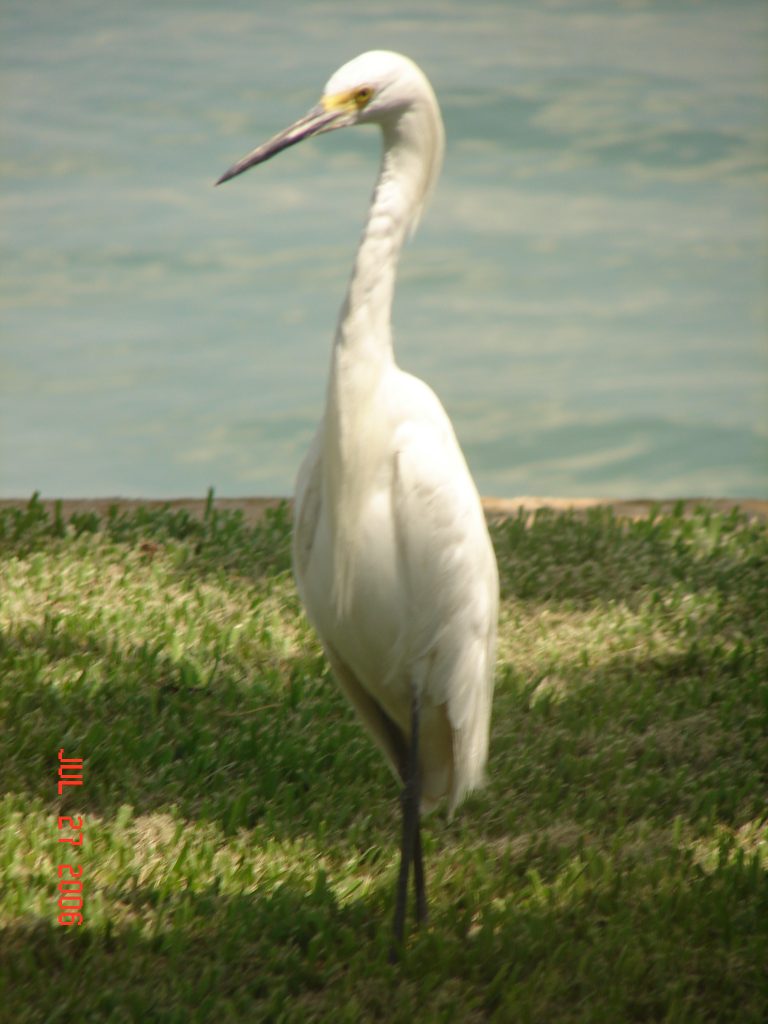

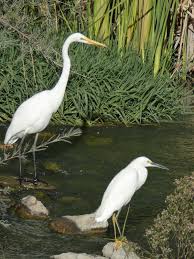
The Great Egret is the symbol of the National Audubon Society. It was founded by the conservationists who wanted to stop the killing of these fabulous birds for their feathers! Thanks to the National Audubon Society, many species of birds have been saved from extinction … and it all started with the Great Egret!
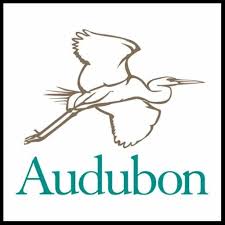
There you have it! Herons, Bittern and Egrets! Fascinating birds found coast to coast, mostly all colony nesters with fabulous colors! Grab your binoculars and cameras, get out there and scope in on some of the Beautiful Bitterns and Egrets of North America! Good birding!

